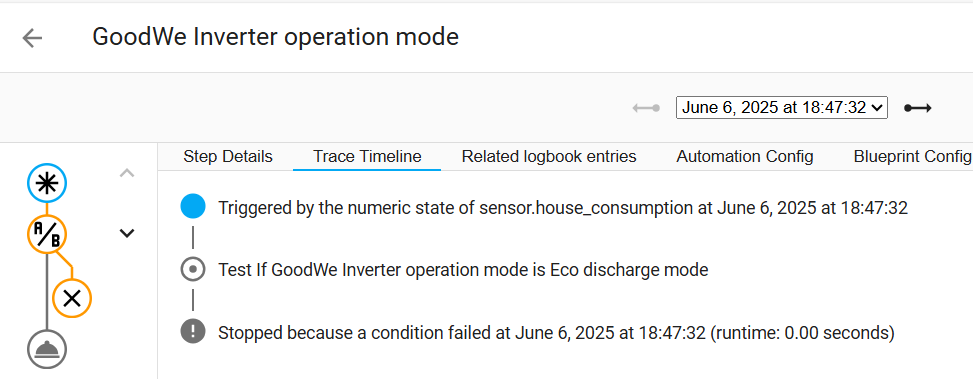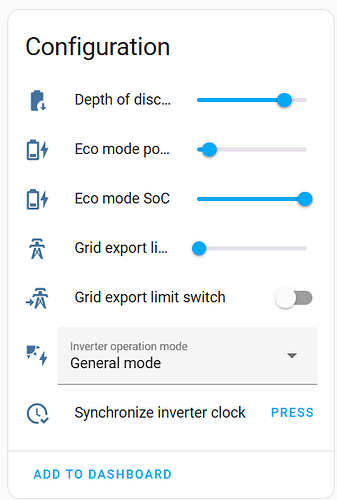Hello everyone! I would like to share set of blueprints for GoodWe PV system users. They should solve some of the most common scenarios in the world of photovoltaics in order to reduce costs of energy. Prerequisites are specified at each blueprint, sometimes you will probably need to define sensor in YAML configuration file but in this kind of situation, example configuration is available.
I would be really grateful for any feedback from you! My work is just in the beginning and I would like to improve it more.
 Home Assistant Blueprints for GoodWe Photovoltaic Systems
Home Assistant Blueprints for GoodWe Photovoltaic Systems
This repository contains a set of Home Assistant blueprints designed to automate and optimize residential photovoltaic systems equipped with GoodWe inverters. These automations focus on smart battery management, solar forecast adaptation and energy optimization tailored to users with solar and battery installations in order to reduce energy costs.
Prerequisites
GoodWe Inverter
The main prerequisite for use this set of blueprints is solar system within Goodwe inverter, baterry system and Home Assistant GoodWe Inverter integration available at GoodWe Inverter - Home Assistant which is native Home Assistant integration. Most of the blueprints assume experimental version of that integration available at GitHub - mletenay/home-assistant-goodwe-inverter: Experimental version of Home Assistant integration for Goodwe solar inverters as a HACS component. Details are mentioned in each blueprint documentation.
Input Season
The blueprints expect that the current season is set to know which scenarios are usable. To define this input select, you as a user can use code below and copy it to configuration.yaml file.
input_select:
season:
name: Season
options:
- Summer
- Spring/Autumn
- Winter
icon: mdi:calendar
 Auto Set DoD
Auto Set DoD
Automatically adjusts the Depth of Discharge (DoD) of the battery based on today’s solar production forecast and your typical energy consumption. It ensures conservative discharge during low production periods (e.g., winter), while allowing deeper discharge during expected sunny days. Standard winter DoD value is set when SoC (state of charge) drops down to that value. The basic GoodWe Inverter integration is expected.
Entities
GoodWe DoD Entity
- Target Depth of Discharge Entity available in GoodWe integration
PV Production Forecast
- Sensor ensuring daily forecast of PV production
- Available from HA integrations like Forecast.Solar which is recommended approach. Eventually you may have access to another service as Solcast etc.
Threshold for Changing DoD
- Number specifiying the PV production prediction value that must be met to start automation (kWh)
- If Prediction is bigger than this value, automation starts, checks other conditions and sets DoD to the new value
Battery Capacity
- Input number defining Battery Capacity
- It’s up on user which value is set
- Available for example after defining in configuration.yaml file or you can have your own input number
input_number:
battery_capacity:
name: Battery Capacity
icon: mdi:battery
min: 0
max: 30
unit_of_measurement: kWh
step: 0.1
Average Daily House Consumption
- Sensor based on Final Daily House Consumption sensor which holds final value of consumption day before
- Contains average daily house consumpiton in last 7 days
- Available for example after defining in configuration.yaml file or you can have your own sensor
sensor:
# statistics sensor for average daily house consumption in last week
- platform: statistics
unique_id: sensor.avg_daily_consumption
name: Average Daily Consumption
entity_id: sensor.final_daily_house_consumption
state_characteristic: mean
sampling_size: 7
max_age:
days: 7
template:
# template sensor for checking final house consumption at the end of the day
- trigger:
- trigger: time
at: "23:59:55"
sensor:
- name: "Final Daily House Consumption"
state: >
{% set value = states('sensor.daily_house_consumption') | float(default=0) %}
{{ value*1 | round(1, default=0) }}
unit_of_measurement: "kWh"
Winter DoD Value
- Input number defining battery Depth of Discharge during winter time
- It’s up on user which value is set
- Available for example after defining in configuration.yaml file or you can have your own input number
input_number:
winter_dod:
name: Winter DoD Value
icon: mdi:battery
min: 0
max: 100
unit_of_measurement: "%"
step: 1
GoodWe SoC Sensor
- Sensor containing actual State of Charge of the battery
- Available directly in GoodWe Inverter integration
 Fully Charge Battery Once a Week
Fully Charge Battery Once a Week
Ensures that the battery is fully charged at least once a week during winter, if it hasn’t been fully charged in the past 7 days. This can help preserve battery health and ensure readiness for colder periods. Triggered at a specific time and only if the production forecast and input season allow it. Experimental GoodWe Inverter integration is expected.
Entities
Time
- Time of start battery charging
Count of 100% Battery State in a Week
- Sensor which holds count of 100% battery charges in last 7 days based on history stats
- Available for example after defining in configuration.yaml file or you can have your own sensor
sensor:
- platform: history_stats
name: Count of 100% Battery State in a Week
entity_id: sensor.battery_state_of_charge
state: 100
type: count
start: "{{ now().replace(hour=0, minute=0, second=0) - timedelta(days=7) }}"
end: "{{ now() }}"
PV Production Forecast
- Sensor ensuring daily forecast of PV production
- Available from HA integrations like Forecast.Solar which is recommended approach. Eventually you may have access to another service as Solcast etc.
GoodWe Charging Power
- Target entity describing power of charging in eco charge mode
- Part of GoodWe Inverter integration
GoodWe Final SoC Entity
- Target entity describing final value of battery charging (%)
- Part of GoodWe Inverter integration
GoodWe Inverter Mode
- Target entity describing mode of the inverter
- Part of GoodWe Inverter integration
GoodWe Soc Sensor
- Sensor containing actual State of Charge of the battery
- Available directly in GoodWe Inverter integration
 Disable Overflow
Disable Overflow
Disables electricity overflow when the spot price of electricity is negative (i.e., Export Limit is set to 0). Once the spot price becomes positive again, it restores the Export Limit to its original value. The basic GoodWe Inverter integration is expected.
Entities
Energy Spot Price
- Actual energy spot price
- Data available from national electricity markets, often also as HA integrations (Nordpool, EPEX, Czech Energy Spot Prices, …)
GoodWe Export Limit
- Target entity describing value of allowed export limit
- Available directly in GoodWe Inverter integration
Export Limit Value
- Numeric value of the original export limit (W) which is set when the price is positive again
 Eco Discharge When Low Price at Noon
Eco Discharge When Low Price at Noon
Checks conditions at specified time (PV prediction, energy prices) and sets eco discharge mode in the morning (moves the overflows from the afternoon to the morning) by script, then sets general mode again when price is low enough (block of 3 consecutive hours is the cheapest) or if the time to full charge of battery is too long. Ideal in spring or autumn period when energy prices are different during the day. Experimental GoodWe Inverter integration is expected.
Entities
Time
- Time when automation start - checks PV production prediction and spot prices for the day
PV Production Forecast
- Sensor ensuring daily forecast of PV production
- Available from HA integrations like Forecast.Solar which is recommended approach. Eventually you may have access to another service as Solcast etc.
Average Daily House Consumption
- Sensor based on Final Daily House Consumption sensor which holds final value of consumption day before
- Contains average daily house consumpiton in last 7 days
- Available for example after defining in configuration.yaml file or you can have your own sensor
sensor:
# statistics sensor for average daily house consumption in last week
- platform: statistics
unique_id: sensor.avg_daily_consumption
name: Average Daily Consumption
entity_id: sensor.final_daily_house_consumption
state_characteristic: mean
sampling_size: 7
max_age:
days: 7
template:
# template sensor for checking final house consumption at the end of the day
- trigger:
- trigger: time
at: "23:59:55"
sensor:
- name: "Final Daily House Consumption"
state: >
{% set value = states('sensor.daily_house_consumption') | float(default=0) %}
{{ value*1 | round(1, default=0) }}
unit_of_measurement: "kWh"
Average PV Power Last 20 Minutes
- Average value of the PV generation during last 20 minutes
- Available for example after defining in configuration.yaml file or you can have your own sensor
sensor:
- platform: statistics
unique_id: sensor.avg_power
name: "Average PV Production In Last 20 Minutes"
entity_id: sensor.pv_power
state_characteristic: mean
sampling_size: 240
max_age:
minutes: 20
Average House Consumption Last 20 Minutes
- Average value of the house consumption during last 20 minutes
- Available for example after defining in configuration.yaml file or you can have your own sensor
sensor:
- platform: statistics
unique_id: sensor.avg_consumption
name: "Average Consumption In Last 20 Minutes"
entity_id: sensor.house_consumption
state_characteristic: mean
sampling_size: 240
max_age:
minutes: 20
Energy Spot Prices for the Day
- Dictionary with hourly prices of energy
- Czech - current_spot_electricity_hour_order
- Nordpool - the only Nordpool entity, default name is “nordpool_<energy_scale>_”
- Available by one of the supported integrations (Czech Energy Spot Prices, Nordpool)
Actual Block of 3 Hours Energy Price Is Cheapest
- Binary sensor defining the cheapest 3 hours block of energy prices
- Czech Energy Spot Prices - contains directly entity of that type
- Nordpool - You have to manually config sensor of that type in configuration.yaml file
Battery Capacity
- Input number defining Battery Capacity
- It’s up on user which value is set
- Available for example after defining in configuration.yaml file or you can have your own input number
input_number:
battery_capacity:
name: Battery Capacity
icon: mdi:battery
min: 0
max: 30
unit_of_measurement: kWh
step: 0.1
GoodWe Discharging Power
- Target entity describing power of discharging in eco discharge mode
- Part of GoodWe Inverter integration
GoodWe Inverter Mode
- Target entity describing mode of the inverter
- Part of GoodWe Inverter integration
GoodWe Soc Sensor
- Sensor containing actual State of Charge of the battery
- Available directly in GoodWe Inverter integration
 Turn Off Eco Discharge Mode When Peak
Turn Off Eco Discharge Mode When Peak
This automation turns off the inverter’s eco discharge mode when consumption exceeds production. It helps in preventing excessive battery discharge when energy consumption is higher than the available solar production.
Experimental GoodWe Inverter integration is expected.
Entities
House Consumption
- Sensor of actual house consumption
- Available directly in GoodWe Inverter integration
PV Power
- Sensor of actual PV generation
- Available directly in GoodWe Inverter integration
GoodWe Inverter Mode
- Target entity describing mode of the inverter
- Part of GoodWe Inverter integration
 Usage
Usage
- Click the “Import Blueprint” button under any blueprint.
- The button will open your Home Assistant UI and pre-load the blueprint import screen.
- Customize entities and parameters as needed in your automation editor.

